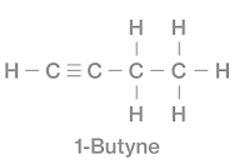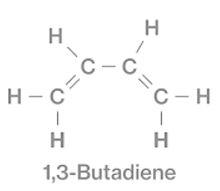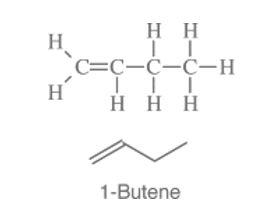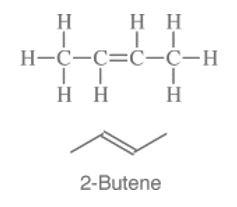
A functional isomer of 1-butyne is:
A. 2 -butyne
B. 1-butene
C. 2-butene
D. 1,3-butadiene
Answer
142.8k+ views
Hint: Functional isomerism is the type of isomerism in which molecules have the same chemical formula but different functional groups attached.
Complete step by step answer:
The structure of 1-butyne is –

That of 1,3-butadiene is –

1 butene has the structure –

2 butene has the structure –

2 butyne-

From these figures we can see that, molecular formula of both 1-butyne and 1,3-butadiene is \[{{\text{C}}_4}{{\text{H}}_6}\]. But their functional group is different. 1-butyne has \[( - {\text{C}} \equiv {\text{C}} - )\]triple bond whereas 1,3-butadiene has double bond \[( - {\text{C = C}} - )\]d. Hence, 1,3-butadiene is the functional isomer of 1-butyne.
So, option D is correct.
Additional information:
In an organic molecule, different atoms are linked to each other with different types of bonds and hence isomerism arises. Functional isomerism is a type of structural isomerism. Apart from functional isomerism, there are five more types of structural isomerism found. These are as follows -
Chain isomerism –
Two compounds having the same molecular formula but show different branched structures show chain isomerism.
Position isomerism –
Two compounds which have the same molecular formula but the position of double/triple bond varies in the chain show position isomerism.
In the above example, 1-butene and 2-butene are examples of position isomerism.
Metamerism –
This type of isomerism arises due to the presence of different alkyl chains on each side of the functional group.
Tautomerism –
When a compound shows two or more interconvertible structures which differ only in terms of relative position of atomic nucleus are called tautomers of each other and the phenomenon is called tautomerism.
Ring chain isomerism-
In ring chain type of isomerism, one structure has a long chain while the other has a ring but the molecular formulas for both are the same.
Note: Remember, when given compounds have the same molecular formula but different functional groups, they are functional isomers of each other. On the other hand, if the position of double/triple bond is different but the molecular formula is same, they show position isomerism.
Complete step by step answer:
The structure of 1-butyne is –

That of 1,3-butadiene is –

1 butene has the structure –

2 butene has the structure –

2 butyne-

From these figures we can see that, molecular formula of both 1-butyne and 1,3-butadiene is \[{{\text{C}}_4}{{\text{H}}_6}\]. But their functional group is different. 1-butyne has \[( - {\text{C}} \equiv {\text{C}} - )\]triple bond whereas 1,3-butadiene has double bond \[( - {\text{C = C}} - )\]d. Hence, 1,3-butadiene is the functional isomer of 1-butyne.
So, option D is correct.
Additional information:
In an organic molecule, different atoms are linked to each other with different types of bonds and hence isomerism arises. Functional isomerism is a type of structural isomerism. Apart from functional isomerism, there are five more types of structural isomerism found. These are as follows -
Chain isomerism –
Two compounds having the same molecular formula but show different branched structures show chain isomerism.
Position isomerism –
Two compounds which have the same molecular formula but the position of double/triple bond varies in the chain show position isomerism.
In the above example, 1-butene and 2-butene are examples of position isomerism.
Metamerism –
This type of isomerism arises due to the presence of different alkyl chains on each side of the functional group.
Tautomerism –
When a compound shows two or more interconvertible structures which differ only in terms of relative position of atomic nucleus are called tautomers of each other and the phenomenon is called tautomerism.
Ring chain isomerism-
In ring chain type of isomerism, one structure has a long chain while the other has a ring but the molecular formulas for both are the same.
Note: Remember, when given compounds have the same molecular formula but different functional groups, they are functional isomers of each other. On the other hand, if the position of double/triple bond is different but the molecular formula is same, they show position isomerism.
Recently Updated Pages
How to find Oxidation Number - Important Concepts for JEE

How Electromagnetic Waves are Formed - Important Concepts for JEE

Electrical Resistance - Important Concepts and Tips for JEE

Average Atomic Mass - Important Concepts and Tips for JEE

Chemical Equation - Important Concepts and Tips for JEE

Concept of CP and CV of Gas - Important Concepts and Tips for JEE

Trending doubts
JEE Main 2025 Session 2: Application Form (Out), Exam Dates (Released), Eligibility, & More

JEE Main Exam Marking Scheme: Detailed Breakdown of Marks and Negative Marking

JEE Main 2025: Derivation of Equation of Trajectory in Physics

Electric Field Due to Uniformly Charged Ring for JEE Main 2025 - Formula and Derivation

Types of Solutions

Degree of Dissociation and Its Formula With Solved Example for JEE

Other Pages
JEE Advanced Marks vs Ranks 2025: Understanding Category-wise Qualifying Marks and Previous Year Cut-offs

JEE Advanced 2025: Dates, Registration, Syllabus, Eligibility Criteria and More

NCERT Solutions for Class 11 Chemistry Chapter 5 Thermodynamics

JEE Advanced Weightage 2025 Chapter-Wise for Physics, Maths and Chemistry

Hydrocarbons Class 11 Notes: CBSE Chemistry Chapter 9

NCERT Solutions for Class 11 Chemistry In Hindi Chapter 1 Some Basic Concepts of Chemistry




